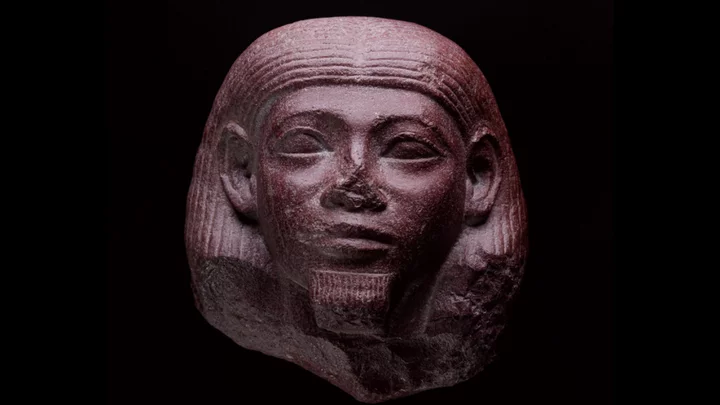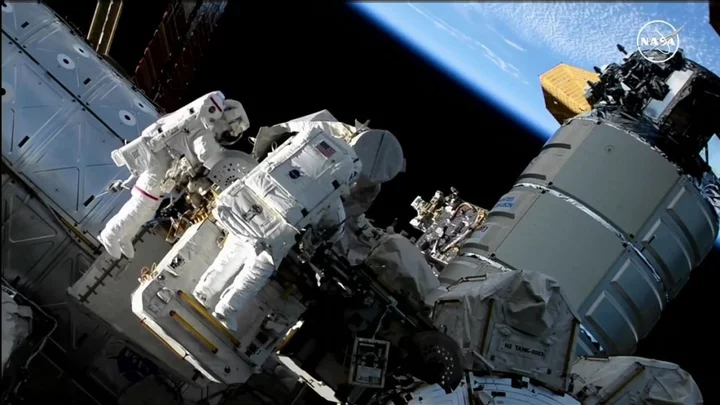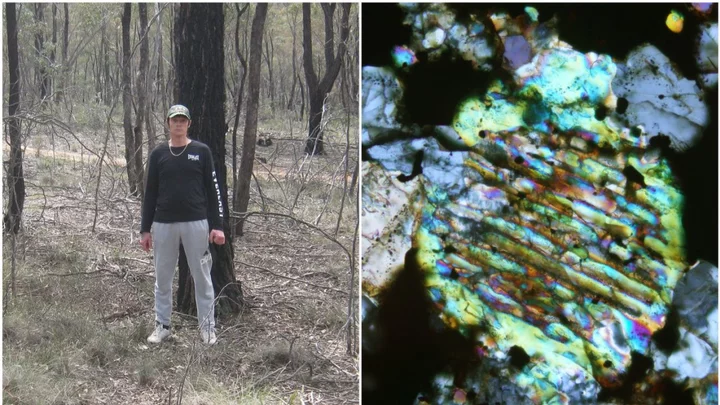
One trillion tonne iceberg escapes from Antartica and is gaining speed
The world’s biggest iceberg is drifting away from the Antarctic after having been grounded there for more than 30 years. The iceberg, which has the catchy name A23a, split from the Antarctic’s giant Filchner Ice Shelf in 1986, but has been stuck to the ocean floor since shortly after that time. Now, according to the British Antarctic Survey, it is on the move. Satellite images show the iceberg drifting past the northern tip of the Antarctic Peninsula. A23a is truly massive. It weighs nearly a trillion metric tonnes and is about three times the size of New York City. It is more than twice the size of Greater London. Scientists say the massive chunk of ice is drifting at a rate of three miles each day. “Over time, it’s probably just thinned slightly and got that little bit of extra buoyancy that’s allowed it to lift off the ocean floor and get pushed by ocean currents,” said Oliver Marsh, a glaciologist at the British Antarctic Survey. Andrew Fleming, a remote sensing expert from the British Antarctic Survey, told the BBC the iceberg had been drifting for the last year, but now appeared to be picking up speed. “I asked a couple of colleagues about this, wondering if there was any possible change in shelf water temperatures that might have provoked it, but the consensus is the time had just come,” he said. Still, some scientists are concerned about how the movement could affect wildlife. The iceberg could end up at the island of South Georgia, which is about 1,000 miles east of the southern tip of South America, which is home to seals, penguins and other seabirds. Chad Greene, a glaciologist at NASA’s Jet Propulsion Laboratory, told the New Scientist large icebergs tend to break off from Antarctica around once per decade. They then get stuck in the Antarctic’s nearly freezing waters, which staves off the melting process, but only for a while. “Icebergs this big can hang around for decades in one place, then one day decide to go for a jolly,” Greene said. “That’s when things get interesting.” How to join the indy100's free WhatsApp channel Sign up to our free indy100 weekly newsletter Have your say in our news democracy. Click the upvote icon at the top of the page to help raise this article through the indy100 rankings.
2023-11-29 22:23

How to see your Spotify Wrapped for 2023?
It's almost that time of year again, when we see how many hours we've shamelessly spent listening to mortifying music and just playing Taylor Swift on loop. Yes, Spotify Wrapped is here again and soon your social media feeds will be full of people either showing you how cool by how much Senegalese lounge Jazz they listen to or embarrassed that they still haven't moved on from The Libertines or The Strokes. Each and every year, even for the most dedicated of music lovers, Spotify Wrapped throws up countless surprises in your top artists and songs leading many to question just how it tallies what you listen to. The past few years Wrapped has arrived earlier and earlier, as reported by the Radio Times, so it's not surprise that its arrived on November 29th. Here are the dates it arrived on the previous years. 2017: 6th December 2018: 6th December 2019: 5th December 2020: 2nd December 2021: 1st December 2022: 30th November Finding your Wrapped couldn't be easier you just need to go to your Spotify app on the day it drops and it'll be there waiting for you at the top of the app alongside your saved songs and albums. Alternatively, if you just use Spotify on a laptop or desktop you can visit spotify.com/wrapped and use it from there. Spotify have never officially said how they compile their data for Wrapped but a Reddit user in 2021 revealed how they believed it works. In the post Hudsonlovestech pointed out six key takeaways that they discovered after downloading their data from the music platform. They were: This year the data was logged from January 1st 00:00 to November 15th 23:59. You have to listen to a song for more than 30 seconds for it to count in your song rankings. Your top songs are calculated by play count rather than total time listened. In your top 100 playlist only the first 10 songs are sorted by play count, the rest are close but sorted by artist. Your total time listening includes podcasts. Your top artists are calculated by total play counts rather than total time listening. If you apply this date to your own listening history then there is a chance you might discover what your Wrapped will look like this year although there is no guarantee. Meanwhile, many users on X/Twitter are posting memes, imagining what their Wrapped will look like this year. To be honest, we're just dreading seeing how much we listened to Ryan Gosling sing 'I'm Just Ken' from the Barbie soundtrack. Sign up to our free indy100 weekly newsletter Have your say in our news democracy. Click the upvote icon at the top of the page to help raise this article through the indy100 rankings.
2023-11-29 21:58

How to predict your 2023 Spotify Wrapped
It's almost that time of year again, when we see how many hours we've shamelessly spent listening to mortifying music and just playing Taylor Swift on loop. Yes, Spotify Wrapped is almost here again and soon you social media feeds will be full of people either showing you how cool by how much Senegalese lounge Jazz they listen to or embarrassed that they still haven't moved on from The Libertines or The Strokes. Each and every year, even for the most dedicated of music lovers, Spotify Wrapped throws up countless surprises in your top artists and songs leading many to question just how it tallies what you listen to. With the big day somewhere on the horizon (it arrived on November 30 in 2022 and December 1 in 2021) music nerds are curious to know what their Wrapped will look like for 2023. Spotify have never officially said how they compile their data for Wrapped but a Reddit user in 2021 revealed how they believed it works. In the post Hudsonlovestech pointed out six key takeaways that they discovered after downloading their data from the music platform. They were: This year the data was logged from January 1st 00:00 to November 15th 23:59. You have to listen to a song for more than 30 seconds for it to count in your song rankings. Your top songs are calculated by play count rather than total time listened. In your top 100 playlist only the first 10 songs are sorted by play count, the rest are close but sorted by artist. Your total time listening includes podcasts. Your top artists are calculated by total play counts rather than total time listening. If you apply this date to your own listening history then there is a chance you might discover what your Wrapped will look like this year although there is no guarantee. Meanwhile, many users on X/Twitter are posting memes, imagining what their Wrapped will look like this year. To be honest, we're just dreading seeing how much we listened to Ryan Gosling sing 'I'm Just Ken' from the Barbie soundtrack. Sign up to our free indy100 weekly newsletter Have your say in our news democracy. Click the upvote icon at the top of the page to help raise this article through the indy100 rankings.
2023-11-29 03:21

How a Scottish boy digging for potatoes found an ancient Egyptian 'masterpiece'
For decades, archaeologists have been trying to work out how a trove of ancient Egyptian artefacts were buried in the grounds of a school in Scotland. In 1952, a schoolboy was sent to dig up potatoes as a punishment – how times have changed – when he found a statue. It turned out to be a masterpiece made some 4,000 years ago. Fourteen years later, more treasure was discovered by a boy during a PE class, before, in 1984, a group found another item with a metal detector. It turned out to be part of a set of 18 antiquities dug up over the next 30 years at Melville House, a historic building in Fife, Scotland. But nobody had any idea how they got there. Now, researchers think they might have unearthed what was going on. Alexander Lesie-Melville was a young heir to Melville House when he travelled to Egypt in 1856. A year later, he had returned to Scotland and died. Leslie-Melville might have picked up the collection on his travels – it certainly beats the Duty Free section at Heathrow – as antique dealers routinely sold ancient artefacts to rich foreigners during that period. After Leslie-Melville died, family members are thought to have moved the objects to an outbuilding, where they were promptly forgotten about. The outbuilding was then demolished. Margaret Maitland, principal curator of the Ancient Mediterranean at National Museums Scotland where most of the objects are housed, said: “The discovery of ancient Egyptian artifacts that had been buried in Scotland for over a hundred years is evidence of the scale of 19th century antiquities collecting and its complex history.” “It was an exciting challenge to research and identify such a diverse range of artefacts.” Dr Elizabeth Goring, who has since investigated the site, said: “Excavating and researching these finds at Melville House has been the most unusual project in my archaeological career, and I’m delighted to now be telling the story in full." The full story will be published in an upcoming article in the journal Proceedings of the Society of Antiquaries of Scotland. How to join the indy100's free WhatsApp channel Sign up to our free indy100 weekly newsletter Have your say in our news democracy. Click the upvote icon at the top of the page to help raise this article through the indy100 rankings.
2023-11-29 02:25

A terrifying thing happens to astronauts' fingernails on a spacewalk
Going on a spacewalk might sound like a lot of fun – but in reality it’s no walk in the park. From their muscles getting less dense all the way to erectile dysfunction, astronauts have to put up with all sorts of things going wrong with their body. And none more gross than what happens to their fingernails. Turns out they just fall right off. The technical term for this is onycholysis, and it has to do with how much – or how little – atmospheric pressure there is in space. Because there is so little ambient pressure in space, astronaut’s space suits need to be pressurised to keep the human body intact. But that’s not good for the hands, it turns out. “Injuries to the hands are common among astronauts who train for extravehicular activity (EVA),” says a 2015 conference paper by space specialists Wyle Laboratories. “When the gloves are pressurized, they restrict movement and create pressure points during tasks, sometimes resulting in pain, muscle fatigue, abrasions, and occasionally more severe injuries such as onycholysis. “Glove injuries, both anecdotal and recorded, have been reported during EVA training and flight persistently through NASA's history regardless of mission or glove model." A 2010 study looked at 232 hand injuries sustained by astronauts, and found that the wider your knuckle joints, the more likely you are to suffer in a space suit. The study suggested that because space suit gloves limit the mobility of these knuckles, the fingers then get put under more pressure. This, in turn, means less blood gets to the fingers, and risks onycholysis. Ouch. Work has been done to try to improve the design of space suit gloves, of course. One team found that the more tailored they were to each astronaut’s finger length the less likely they were to lose their fingernails. That’s no mean feat, however. These gloves are made of at least four layers: one which touches the skin, one which helps create the pressurised environment, another one which makes the pressure layer less stiff, and an outer layer which protects the astronaut from everything on the outside. Mercifully for NASA astronauts at least, they usually have their gloves fitted to each wearer, and with new space suit design moving forward each day, the number of injuries is decreasing. Nonetheless, it sounds like a trip to space is no time for a manicure. How to join the indy100's free WhatsApp channel Sign up to our free indy100 weekly newsletter Have your say in our news democracy. Click the upvote icon at the top of the page to help raise this article through the indy100 rankings.
2023-11-28 21:50

New research suggests dinosaurs were wiped out by more than just a meteorite
We’ve all been told the story of what wiped out the dinosaurs – a giant meteor careers down from the sky, crashes into Earth and bang! The rest is history. But what if that wasn’t the whole story? A new study suggests there may have been more to it than just an asteroid – and it involves climate change. A chain of huge volcanic eruptions which eventually cooled the planet an alarming amount may have been partially to blame, according to research. The study, published in Science Advances and co-authored by Don Baker, a professor in McGill University's Department of Earth and Planetary Sciences, suggests that this might be the case. The researchers looked into volcanic eruptions at the Deccan Traps, a huge, rugged plateau that formed when molten lava solidified and turned to rock. The plateau dates back to around 66-65m years ago, when magma from deep inside Earth erupted to the surface. That just so happens to be around the time when scientists think the dinosaurs met their demise. Baker’s team suggest that the eruptions produced a staggering 1m cubic kilometres of lava, which then turned into rock, which may have played a key role in cooling the global climate around 65m years ago. The scientists say it’s all to do with how much sulphur and fluorine was pumped into the atmosphere as a result of the eruptions. Incredibly, they found the event could have sparked a drop in temperature all around the world, dubbed a “volcanic winter”. Baker said: “Our research demonstrates that climatic conditions were almost certainly unstable, with repeated volcanic winters that could have lasted decades, prior to the extinction of the dinosaurs. “This instability would have made life difficult for all plants and animals and set the stage for the dinosaur extinction event. “Thus our work helps explain this significant extinction event that led to the rise of mammals and the evolution of our species.” The scientists worked it out using new chemical techniques developed at McGill to measure how much sulphur is in the rock formations which came about at the time, then from that, figuring out how much went into the atmosphere. The paper is titled “Recurring volcanic winters during the latest Cretaceous: Sulfur and fluorine budgets of Deccan Traps lavas.” How to join the indy100's free WhatsApp channel Sign up to our free indy100 weekly newsletter Have your say in our news democracy. Click the upvote icon at the top of the page to help raise this article through the indy100 rankings.
2023-11-28 21:25

Ex-Apple employee reveals game-changing iPhone hacks everyone should know
A former Apple employee has been sharing some of the handy iPhone hacks he learnt while working at the tech giant - and we can't believe we didn't know them before. From tips as simple as holding your camera button down to record a video instead of swiping, to switching to a 'one-handed keyboard' to save your muscles aching, Tyler Morgan has completely changed the way his followers are using their phones. Arguably one of the most popular he recommended is that you can actually do voiceovers while screen recording, by swiping down to reveal a microphone button. Sign up to our new free Indy100 weekly newsletter
2023-11-28 00:53

Metal detectorist finds mystery rock that turns out to be worth more than gold
Metal detecting can be a pretty thankless task, with most enthusiasts lucky if they find a couple of quid or an old belt buckle. But for one man in Australia, the experience was out of this world. David Hole was out digging for gold in Maryborough Regional Park, near Melbourne, back in 2015 when his trusty detector alerted him to a strange, red-brown rock embedded in some yellow clay. Hole took the mysterious boulder home with him and did his utmost to crack it open, using a rock saw, a sledgehammer, a drill, and even dousing it in acid, according to Science Alert. And yet, nothing left so much as a dent. Admitting defeat years later, in 2018, Hole took his find to the Melbourne Museum, hoping someone there could explain its impenetrability; convinced it contained a golden nugget. However, the discovery was far more significant than a precious metal: it was a 4.6 billion-year-old glimpse at the birth of our solar system – a rare meteorite that had crashed down to Earth. The museum’s geologists, Dermot Henry and Bill Birch, said they grew excited as soon as Hole pulled the enigmatic rock from his rucksack. Speaking to the Sydney Morning Herald back in 2019, Henry recalled: "It had this sculpted, dimpled look to it. "That's formed when they come through the atmosphere, they are melting on the outside, and the atmosphere sculpts them." Meanwhile, Birch told the paper he knew the specimen was special as soon as he held it. “If you saw a rock on earth like this, and you picked it up, it shouldn’t be that heavy,” he said. Testing soon confirmed their suspicions, as well as the composition of this extraordinary chunk of history. In July 2019, the two colleagues published a scientific paper describing the meteorite, which they christened “Maryborough”, after the area where it was found. The space rock, which measures 38.5cm by 14.5cm by 14.5cm, weighs a staggering 17 kg, and after using a diamond saw to slice through it, the experts discovered that it is what is known as an H5 ordinary chondrite. This means that it contains tiny crystallised droplets (chondrules), that were created by flash heating of dust clouds in the early solar system. "Meteorites provide the cheapest form of space exploration. They transport us back in time, providing clues to the age, formation, and chemistry of our Solar System (including Earth)," Henry said in a statement published by Museums Victoria. "Some provide a glimpse at the deep interior of our planet. In some meteorites, there is 'stardust' even older than our Solar System, which shows us how stars form and evolve to create elements of the periodic table. "Other rare meteorites contain organic molecules such as amino acids; the building blocks of life." The scientist added that the Maryborough Meteorite was most likely formed in the asteroid belt between Mars and Jupiter. Despite all of Henry and Birch’s work, plenty of questions surrounding the rock remain unanswered. They don’t know for sure when it landed on Earth, with carbon 14 testing it was between 100 and 1,000 years ago. Still, multiple meteor sightings were reported in the Maryborough district between 1889 and 1951, so it could have crashed down within this relatively recent time period. Whatever its precise origins, the researchers insist it’s worth more to science than its weight in gold. "This is only the 17th meteorite found in Victoria, whereas there's (sic) been thousands of gold nuggets found," Henry told Channel 10 News at the time. "Looking at the chain of events, it's quite, you might say, astronomical it being discovered at all." Birch echoed this sentiment, adding: “When you consider all the events this chunk of rock has experienced since its formation 4.6 billion years ago, it's really mind-boggling that we get the opportunity to hold it and study it today. How good is that?" Sign up for our free Indy100 weekly newsletter Have your say in our news democracy. Click the upvote icon at the top of the page to help raise this article through the indy100 rankings
2023-11-26 23:24

Women may have been better hunters than men, scientists find
Scientists are challenging the way many people think about ancient hunter gatherers, after finding that women may have been better hunters than men. New findings have shown that while there are clear differences between the sexes when it comes to biology, the idea of men being naturally better suited to hunting is a myth. New research from professor Cara Ocobock points to women being metabolically better placed to hunt. Ocobock is an assistant professor in the Department of Anthropology and director of the Human Energetics Laboratory at the University of Notre Dame. She published a study on the subject alongside anthropologist Sarah Lacy at the University of Delaware. The research also points to female hunters dating back to the Holocene period which were uncovered buried with hunting tools – and they’re challenging widely held assumptions over gender roles with the study. Ocobock said in a statement: "This was what everyone was used to seeing. This was the assumption that we've all just had in our minds and that was carried through in our museums of natural history." “Here we review and present emerging physiological evidence that females may be metabolically better suited for endurance activities such as running, which could have profound implications for understanding subsistence capabilities and patterns in the past,” the pair wrote. That’s due to the fact that the presence of the hormones estrogen and adiponectin give women the upper hand when it comes to endurance – a factor which would have been “critical in early hunting because they would have had to run the animals down into exhaustion before actually going in for the kill”. The presence of those hormones is better for modulating fat and glucose. As such, estrogen makes the body use stored fats for energy before turning to carbohydrates. “Since fat contains more calories than carbs do, it’s a longer, slower burn, which means that the same sustained energy can keep you going longer and can delay fatigue,” Ocobock said. “Estrogen is really the unsung hero of life, in my mind. It is so important for cardiovascular and metabolic health, brain development and injury recovery.” “With the typically wider hip structure of the female, they are able to rotate their hips, lengthening their steps. The longer steps you can take, the ‘cheaper’ they are metabolically, and the farther you can get, faster.” “When you look at human physiology this way, you can think of women as the marathon runners versus men as the powerlifters.” Sign up for our free Indy100 weekly newsletter How to join the indy100's free WhatsApp channel Have your say in our news democracy. Click the upvote icon at the top of the page to help raise this article through the indy100 rankings
2023-11-25 21:56

Ancient Chinese city found perfectly preserved at the bottom of a lake
Submerged beneath a manmade lake in China lies a forgotten city, dubbed by experts as “China’s Atlantis”. The underwater city, known as the Lion City or Shi Cheng, is hidden 40 metres beneath the surface of Qiandao Lake in eastern China. In 2001, officials discovered – or rediscovered – that the metropolis had been perfectly preserved after years underwater, and by 2017 had opened it up as a diving site for tourists. But what is the history of the Lion City, and how did it end up underwater? Shi Cheng is thought to have been built during the Eastern Han Dynasty between 25AD and 200AD. It was once a political and economic hub in the eastern province of Zhejiang, with a regional seat of power located in the city. The city walls, believed to date back to the 16th century, had five entrance gates, as opposed to the traditional four in old Chinese cities, and its wide streets contain 265 archways featuring stonework of dragons, phoenixes and (you guessed it) lions. However, in 1959, the Chinese government decided to build a hydroelectric power plant in the area and, somewhat shockingly, decided to flood the city to do it. This didn’t just amount to getting rid of a historical artefact. More than 300,000 people needed to be rehoused for the project, which ultimately birthed Qiandao Lake. A surprising side effect to this was that the city remains as a time capsule to the period when it was flooded. Since the water used to submerge it did not contain anything corrosive, and was not conducive to marine life, the remains are in perfect condition. And even though it was still functioning as a city until the mid-20th century, the Lion City has still not been completely mapped out. Now, divers are slowly working through each building, structure, archway, road and house to eventually put together a full picture of what it would have looked like. Until then, it will remain at least party shrouded in mystery, as China’s very own Atlantis. How to join the indy100's free WhatsApp channel Sign up to our free indy100 weekly newsletter Have your say in our news democracy. Click the upvote icon at the top of the page to help raise this article through the indy100 rankings.
2023-11-24 23:51

Scientists discover that bacteria has 'memories' that pass on to future generations
Scientists have made an astonishing discovery that suggests bacteria contain memories to be passed on to future generations. Researchers at the University of Texas and the University of Delaware found that despite having no brain or nervous system, certain bacteria may be able to form memories and remember certain behaviours depending on the available cellular iron. When iron levels are low, bacteria can hunt for local iron in their environment, prompting scientists to believe its memory has evolved, according to Science Alert. "Bacteria don’t have brains, but they can gather information from their environment, and if they have encountered that environment frequently, they can store that information and quickly access it later for their benefit," Souvik Bhattacharyya, the lead author of the recent study said. "We show [...] that a prior experience of swarming is remembered when Escherichia coli encounters a new surface, improving its future swarming efficiency," Souvik explained. "An iron-based memory might offer the advantage of providing a hub connecting various stress responses such as antibiotic survival and biofilms." The 'memories' lasted for around four generations, before generally coming to an end by the seventh. "Before there was oxygen in the Earth’s atmosphere, early cellular life was utilizing iron for a lot of cellular processes. Iron is not only critical in the origin of life on Earth, but also in the evolution of life,” the study author went on to explain. "It makes sense that cells would utilize it in this way." How to join the indy100's free WhatsApp channel Sign up for our free Indy100 weekly newsletter Have your say in our news democracy. Click the upvote icon at the top of the page to help raise this article through the indy100 rankings.
2023-11-24 22:21

Science has determined what the optimum length of time we should spend in a bath
There's nothing better than a hot bath to warm up and unwind on a chilly winter evening - but water bills don’t come cheap, so it’s more important than ever to make sure you’re making the most of your time in the tub. So how long should we be spending in the bath? Well, a recent study has uncovered that 22 minutes is the optimum length of time to spend in the bath. The study conducted by Victorian Plumbing sought to discover ULTIMATE bath time for relaxation, hydration and a good night’s sleep. There were 20 participants involved in the experiment - half male and half female - who took baths of varying lengths and rated how they felt afterward based on a number of factors. The study concluded that 22 minutes is the optimum amount of time to spend in the tub - to feel relaxed, hydrated, and sleep well after. Soaking should stop at 27 minutes if you don’t want to stay feeling hydrated post-bath, according to the study. This supports the advice of some professionals, who suggest that baths should be no longer than 30 minutes. It was also uncovered that baths impact men and women slightly differently. Women have a better night’s sleep after a longer bath, ideally, 30 minutes long, whereas men sleep better after 19 minutes. Those who felt more relaxed after the baths had scrolled on their phone during their time in the tub, whereas those who watched TV were found to be the least. Sorry to burst your bubble bath lovers, but the findings also suggest that people who take more baths are generally more stressed - although they find them more relaxing than shower- on the whole. “When the nights start getting colder in the UK, we tend to see an increase in Brits looking to buy a bath. And who can blame them? There are a number of benefits of a bath; they’re soothing, and cleansing and studies have even suggested that there are similar benefits to exercise," Brenna Ryan from Victorian Plumbing said about the study's findings. “To help you get the most out of your bath, we conducted a study which found that the optimum time to spend in the tub is 22 minutes - to leave you feeling relaxed, hydrated and sleep like a baby.” How to join the indy100's free WhatsApp channel Sign up to our free Indy100 weekly newsletter Have your say in our news democracy. Click the upvote icon at the top of the page to help raise this article through the indy100 rankings.
2023-11-24 19:59
